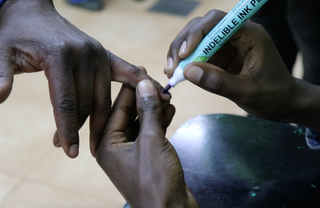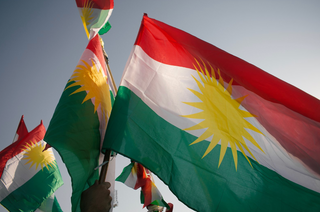News
Lessons from Kenya's Knife-Edge Presidential Election
The relatively peaceful nature of the tussle this time around — hundreds have died during previous post-election confrontations — suggests that Kenya's democratic tradition is alive and well.

Director, The Brenthurst Foundation

Research Director, The Brenthurst Foundation

Senior Researcher, The Brenthurst Foundation

Kenya's Supreme Court has upheld the election of William Ruto as president following a post-election tussle with his rival, Raila Odinga, over the outcome of the election held on 9 August.
The relatively peaceful nature of the tussle this time around — hundreds have died during previous post-election confrontations — suggests that Kenya's democratic tradition is alive and well. What were the lessons from the election?
When the polling station at Westlands Primary in Nairobi did not open on time, the crowd gathered at the gate began to chant: “We want to vote! We want to vote!” It was emblematic of the commitment of Kenyans to the most fundamental act of citizenship in a democracy.
When the final ballot box was delivered, the gates opened and voters streamed in to queue up to cast their ballots.
The election, held on 9 August, threw into stark relief the successes and challenges faced by Africa's democracies.
There can be no gainsaying that voting day was a monumental organisational achievement with 22 million registered voters, 46,232 polling stations, 380,000 workers at the Independent Electoral and Boundaries Commission (IEBD), the deployment of 100,000 armed police, 18,000 election observers from 1,200 NGOs, 700 voters per polling station, 290 constituencies, 47 counties, and six different ballot papers for governors, senators, representatives for women and one president.
From what we saw as members of The Brenthurst Foundation's election observer team, which monitored voting day in four major regions (Nairobi, Mombasa, Eldoret and Kisumu), voting took place in a calm atmosphere free from intimidation as the young polling station officials who were in charge showed good leadership and transparency.
But the Kenyan election was more than just a series of statistics. Voting took place against a backdrop of heated political contestation. As Ruto observed ahead of the vote: “We are at a defining moment in an election that is different, where the sitting president is supporting the leader of the opposition. The real candidate I am running against is not the leader of the party, but my boss.”
His rival, former prime minister Odinga, the candidate backed by Ruto's “boss”, President Uhuru Kenyatta, asked at his final rally: “Whose hands will dismantle the bandit economy of corruption. In whose hands are your families safe?”
Ruto expressed concerns about ballot stuffing, the bias of the Inspector-General of Police, the capturing of the media and those who wish “to foment a situation to introduce the old mistrust”.
As a consequence of the tribal make-up of Kenyan society, Ruto particularly drew attention to his home-ground in the Rift Valley as an area of potential electoral malfeasance, while others expressed concerns about the potential for violence, especially in the highly contested Central Region.
Kenyan politics have traditionally been defined along ethnic lines based on elite-driven deal-making coalitions. The 2002 election was fought by an alliance between Mwai Kibaki and Odinga against Kenyatta, 2007 by Odinga and Ruto versus Kibaki and Kenyatta, and 2012 and 2017 by Kenyatta and Ruto versus Odinga. Now Odinga had effectively teamed up with Kenyatta to fight against Ruto.
It is tempting to focus on these alliances and tendencies rather than the democratisation process itself.
In that regard, this election represented a number of strategic advances for Kenya, including a sitting president retiring after ending a second term. The IEBC had the opportunity to implement learnings from previous elections, and women were much more to the fore than in previous years. The economy, which usually suffers in the lead-up to voting, had proven more robust this time around.
All of this promised to erase the history of electoral controversy and violence. In the December 2007 election, which disintegrated into violence, especially in the Rift Valley, more than 1,000 people died and as many as 650,000 were displaced. The negotiation of a government of national unity followed. The August 2017 election, contested principally by Kenyatta and Odinga, was similarly controversial, with the first round of the presidential contest overturned by the Supreme Court, though Odinga refused to take part in the run-off. The court decision was highly critical of the IEBC.
Odinga's reconciliation with Kenyatta in March 2018 and the subsequent Building Bridges Initiative set the stage for the 2022 election pact.
Then there are the contemporary, more technical aspects, especially concerning the management of the transmission of results from polling stations to constituencies and counties and on to the national tallying centre in Nairobi. The counting process was manual, and the audit of results was possible through their public publication. The (biometric) registration technology created some suspicion, leading to a “triple” hybrid method of voter identification: fingerprints, ID numbers, photographs with identity cards and then, when all else failed, a manual register.
The use of the manual register became the subject of court battles and, finally, on the eve of the election, the Court of Appeal ruled to temporarily stop a High Court order allowing a manual voters' register to be used.
The management of the results — and their acceptance — is where the rubber hits the road. Voting day's transparency — with votes counted in each polling station in full view of party agents and the agreed-on result being available to all for scrutiny, gave way to opacity as the results were tallied at the IEBC's headquarters in Bomas, Nairobi.
Kenya's complex reporting system begins with the filing of a 34A form by the presiding officer of each voting station. This is the raw data on which the election result ought to be based.

The 34A forms are electronically submitted to the constituency tallying centre.
The constituency returning officer then fills in form 34B, which is used for the collation of presidential results. The 34B forms are then handed to the IEBC where the final tally is made and released using form 34C.
Sceptics have argued that the 34B step is unnecessary and introduces another link into the chain, increasing the opportunity for the manipulation of results. To counter this, the 34A forms are posted at voting stations so that voters can compare the result with that published by the IECB after tallying.
What played out in the days following voting on 9 August appeared to back this up. The behind-closed-doors tallying process was described as “opaque” by four of the IEBC's seven commissioners, who said they could not back the announcement of Ruto as the winner of the election by the head of the IEBC, Wafula Chebukati.
The result was challenged in court by Odinga, leading to this week's court decision in favour of Ruto.
Despite the assurances received from the IEBC chair, commissioners and staff to the contrary, the delegation heard oft-repeated concerns from stakeholders and key actors that the IEBC had not undertaken the reforms required of it by the Kenyan Supreme Court in its findings on the 2017 general elections. These concerns lead many, though not all consulted, to conclude that the IEBC was not adequately prepared to administer a free and fair electoral process going into 9 August. Views are mixed on whether this was by design or due to lack of competence, or an unfair assessment of the preparations.
This is not an easy time to host an election in Africa. Democracy is under siege. The number of “free” countries across the continent has declined in recent years as populists and malign foreign players such as Russia and its Wagner militia attempt to hollow out democratic institutions and turn countries into vassals for a powerful elite. Foreigners remain tempted by the “big man” thesis in Africa, but only if they can influence which big man seizes power. And African governance systems have usually been too weak — or too predatory — to resist such influences.
From what we saw across the 461 polling stations viewed by our observer mission, Kenya's people were determined to stop this pestiferous tide and entrench democracy. But the full value of this competitive process — and its veracity — will be determined by what comes now; whether the result is accepted on the ground by the majority, and how the government performs in the interests of the people.
This article originally appeared on the Daily Maverick
Photo: Brenthurst Foundation

